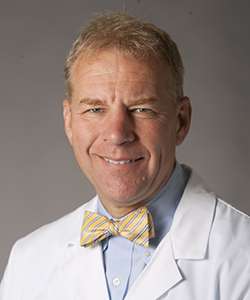A key puzzle piece to curbing Vermont’s opioid epidemic has emerged just across the Connecticut River at Dartmouth College.
Dr. Richard Barth, chief of general surgery at Dartmouth Hitchcock Medical Center, has completed three studies on what’s considered an ideal dosage of opioids to prescribe to a patient leaving a hospital after major surgery.

Dr. Richard Barth is chief of general surgery at Dartmouth-Hitchcock.
He claims that smart policy can reduce opioid prescriptions by as much as 40 percent while still adequately mitigating serious pain for patients.
Many experts tie rising opioid prescriptions to the national opioid epidemic. In some cases, overdose deaths have been traced back to prescriptions signed by surgeons.
In Barth’s study published in the Journal of the American College of Surgeons, the main takeaway is that the level of opioids a patient is taking in the hospital should stay relatively consistent even after leaving the hospital.
“This guideline was true for multiple different operations,” Barth said. “It didn’t matter whether someone had a colon operation, liver procedure or hernia repair; no matter what type of general surgery operation they had, this association held throughout all procedures studied. So, the beauty of this finding is that one guideline would apply for multiple different surgical procedures.”
While several states including Vermont have laws in place to better control opioid prescriptions, Barth said the laws are somewhat ambiguous. For example, he said some New England states will limit prescriptions to a seven-day supply, but there is no guidance on the dosage.
“So a seven-day supply could be 84 pills or 21 pills,” Barth said. “[This] is much more patient-specific than the broad laws that are being handed down.”
The guidelines he proposes include zero pills for patients who took no opioids the day prior to leaving the hospital, 15 pills for patients who took one to three pills the day before, and 30 pills for those who took four or more pills on their last day in the hospital.
Barth told True North that prescribing drugs consistent with what’s already being taken at the hospital is not a common practice. He noted surgeons may often feel the temptation to give out a little extra so as to avoid having the patient return for a refill.
“That’s not really acceptable,” he said. “We found that we were over-prescribing … this wouldn’t surprise any surgeon.”
He said patients often just use 38 percent of the drugs prescribed, so the remaining 62 percent simply stay in medicine cabinets and often end up stolen, abused, or sold.
“I think our findings are generalizable across the whole country,” Barth added.
The methodology included 333 hospital inpatients discharged to home after six different types of general surgery operations. Those operation types included bariatric (obesity) procedures; operations on the stomach, liver, and pancreas; ventral hernia repair; and colon operations.
Researchers followed up with patients by using questionnaires and phone surveys following release from hospitalization. About 90 percent completed the follow-up process. Chronic opioid users were not included in the study group.
Barth said one alternative to opioids is to prescribe a combination of Tylenol and Ibuprofen. About 85 percent of post-surgery pain can be controlled by a regimen of acetaminophen and ibuprofen. That in turn could result in a 53 percent reduction in opioid use by outpatients.
This is the third study Barth and his team have done on post-surgery prescriptions. The two prior studies indicated that a majority of outpatient surgeries for gallbladder, breast, and hernia repair required fewer opioids than currently prescribed. This is the first study to offer guidelines for practicing surgeons.
Michael Bielawski is a reporter for True North Reports. Send him news tips at bielawski82@yahoo.com and follow him on Twitter @TrueNorthMikeB.


